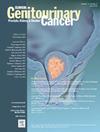早期复发的转移性纯精原细胞瘤:高剂量化疗和残余疾病手术的预后作用。
IF 2.3
3区 医学
Q3 ONCOLOGY
引用次数: 0
摘要
简介:转移性半瘤性生殖细胞肿瘤是一种罕见的癌症。很少有研究关注早期复发(方法:回顾性纳入了2005年至2023年期间在7个法国专家中心接受治疗的91例mSGCT患者,这些患者最初对一线ChT有良好的反应后早期复发。评估患者临床特征、首次复发后无进展生存期(PFS)和总生存期(OS)。我们还评估了HDCT-HSCT作为首次救助治疗的作用,以及补救性ChT后补充RPLND的影响。结果:中位随访56个月后,3年PFS和OS率分别为77.6% (95% CI, 68.3-88.1)和88.4% (95% CI, 81.0-96.4)。与标准剂量二线ChT相比,HDCT-HSCT与更长的PFS或OS无关。相比之下,在补救性ChT术后接受RPLND的患者表现出更长的PFS(3年:97.1% vs. 63%;人力资源0.15;95% ci, 0.03-0.65;P = 0.012), OS改善趋势显著(3年:97.0% vs. 81.8%;人力资源0.15;95% ci, 0.02-1.23;P = .078)。结论:挽救性治疗后的RPLND可改善第一年复发的mSGCT患者的PFS和OS。然而,该研究的回顾性限制了因果推断,影响治疗选择的预后因素有待进一步探讨。确定可能受益于HDCT-HSCT的亚群是有必要的。本文章由计算机程序翻译,如有差异,请以英文原文为准。
Metastatic Pure Seminomas With Early Relapse: Prognostic Roles of High Dose Chemotherapy and Surgery of Residual Disease
Introduction
Metastatic seminomatous germ cell tumors (mSGCT) are a rare form of cancer. Few studies focused on early relapse (<12 months) after first-line chemotherapy (ChT). We aimed to retrospectively evaluate the impact of salvage retroperitoneal lymph node dissection (RPLND) and high-dose ChT with hematopoietic stem cell transplantation (HDCT-HSCT) in mSGCT patients in a situation of early relapse.
Methods
Ninety-one mSGCT patients treated between 2005 and 2023 in 7 French expert centers for an early recurrence after an initial favorable response to first-line ChT were retrospectively included. Patient clinical characteristics, progression-free survival after first relapse (PFS) and overall survival (OS) were evaluated. We also assessed the role of HDCT-HSCT as first salvage treatment, and the impact of complementary RPLND after salvage ChT.
Results
After a median follow-up of 56 months, 3-year PFS and OS rates were 77.6% (95% CI, 68.3-88.1) and 88.4% (95% CI, 81.0-96.4), respectively. HDCT-HSCT was not associated with longer PFS or OS compared to standard-dose second-line ChT. In contrast, patients who underwent RPLND after salvage ChT demonstrated significantly longer PFS (at 3-years: 97.1% vs. 63%; HR 0.15; 95% CI, 0.03-0.65; P = .012) and a notable trend towards improved OS (at 3-years: 97.0% vs. 81.8%; HR 0.15; 95% CI, 0.02-1.23; P = .078).
Conclusion
RPLND after salvage treatment could be associated with improved PFS and OS in mSGCT patients with first-year relapse. However, the retrospective nature of the study limits causal inference, and prognostic factors influencing treatment selection should be further explored. Identifying subpopulations that might benefit from HDCT-HSCT is warranted.
求助全文
通过发布文献求助,成功后即可免费获取论文全文。
去求助
来源期刊

Clinical genitourinary cancer
医学-泌尿学与肾脏学
CiteScore
5.20
自引率
6.20%
发文量
201
审稿时长
54 days
期刊介绍:
Clinical Genitourinary Cancer is a peer-reviewed journal that publishes original articles describing various aspects of clinical and translational research in genitourinary cancers. Clinical Genitourinary Cancer is devoted to articles on detection, diagnosis, prevention, and treatment of genitourinary cancers. The main emphasis is on recent scientific developments in all areas related to genitourinary malignancies. Specific areas of interest include clinical research and mechanistic approaches; drug sensitivity and resistance; gene and antisense therapy; pathology, markers, and prognostic indicators; chemoprevention strategies; multimodality therapy; and integration of various approaches.
 求助内容:
求助内容: 应助结果提醒方式:
应助结果提醒方式:


